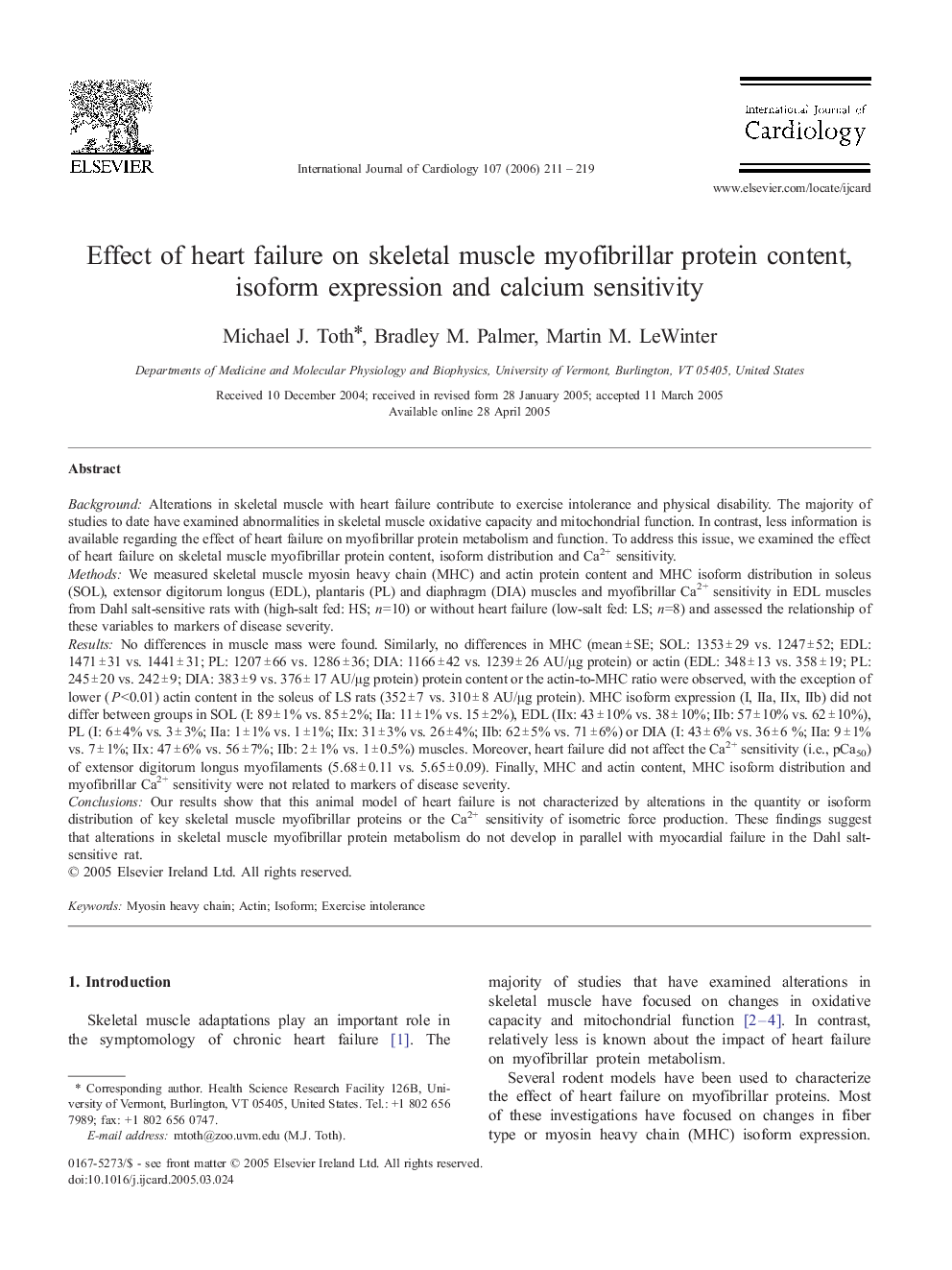| Article ID | Journal | Published Year | Pages | File Type |
|---|---|---|---|---|
| 2936915 | International Journal of Cardiology | 2006 | 9 Pages |
BackgroundAlterations in skeletal muscle with heart failure contribute to exercise intolerance and physical disability. The majority of studies to date have examined abnormalities in skeletal muscle oxidative capacity and mitochondrial function. In contrast, less information is available regarding the effect of heart failure on myofibrillar protein metabolism and function. To address this issue, we examined the effect of heart failure on skeletal muscle myofibrillar protein content, isoform distribution and Ca2+ sensitivity.MethodsWe measured skeletal muscle myosin heavy chain (MHC) and actin protein content and MHC isoform distribution in soleus (SOL), extensor digitorum longus (EDL), plantaris (PL) and diaphragm (DIA) muscles and myofibrillar Ca2+ sensitivity in EDL muscles from Dahl salt-sensitive rats with (high-salt fed: HS; n=10) or without heart failure (low-salt fed: LS; n=8) and assessed the relationship of these variables to markers of disease severity.ResultsNo differences in muscle mass were found. Similarly, no differences in MHC (mean ± SE; SOL: 1353 ± 29 vs. 1247 ± 52; EDL: 1471 ± 31 vs. 1441 ± 31; PL: 1207 ± 66 vs. 1286 ± 36; DIA: 1166 ± 42 vs. 1239 ± 26 AU/μg protein) or actin (EDL: 348 ± 13 vs. 358 ± 19; PL: 245 ± 20 vs. 242 ± 9; DIA: 383 ± 9 vs. 376 ± 17 AU/μg protein) protein content or the actin-to-MHC ratio were observed, with the exception of lower (P<0.01) actin content in the soleus of LS rats (352 ± 7 vs. 310 ± 8 AU/μg protein). MHC isoform expression (I, IIa, IIx, IIb) did not differ between groups in SOL (I: 89 ± 1% vs. 85 ± 2%; IIa: 11 ± 1% vs. 15 ± 2%), EDL (IIx: 43 ± 10% vs. 38 ± 10%; IIb: 57 ± 10% vs. 62 ± 10%), PL (I: 6 ± 4% vs. 3 ± 3%; IIa: 1 ± 1% vs. 1 ± 1%; IIx: 31 ± 3% vs. 26 ± 4%; IIb: 62 ± 5% vs. 71 ± 6%) or DIA (I: 43 ± 6% vs. 36 ± 6 %; IIa: 9 ± 1% vs. 7 ± 1%; IIx: 47 ± 6% vs. 56 ± 7%; IIb: 2 ± 1% vs. 1 ± 0.5%) muscles. Moreover, heart failure did not affect the Ca2+ sensitivity (i.e., pCa50) of extensor digitorum longus myofilaments (5.68 ± 0.11 vs. 5.65 ± 0.09). Finally, MHC and actin content, MHC isoform distribution and myofibrillar Ca2+ sensitivity were not related to markers of disease severity.ConclusionsOur results show that this animal model of heart failure is not characterized by alterations in the quantity or isoform distribution of key skeletal muscle myofibrillar proteins or the Ca2+ sensitivity of isometric force production. These findings suggest that alterations in skeletal muscle myofibrillar protein metabolism do not develop in parallel with myocardial failure in the Dahl salt-sensitive rat.
